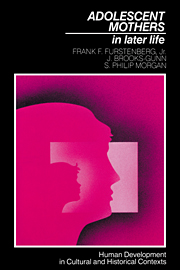Book contents
- Frontmatter
- Contents
- List of tables and figures
- Preface
- 1 Reassessing adolescent parenthood
- 2 Experience in adulthood
- 3 Pathways to success in adulthood
- 4 The children's experience
- 5 The intersecting life courses of adolescent mothers and their children
- 6 The life course of adolescent mothers: implications for public policy
- Appendixes
- A Life-history calendar
- B Reliability
- C Analysis of sample attrition for bias
- D Description of data sets used for comparison of socioeconomic variables with Baltimore data set in Table 2.2
- E Methods and procedures used in Chapter 3
- F Description and details of multivariate analysis reported in Chapter 4 and 5
- G Procedure for computing summary statistics in Chapter 6
- Bibliography
- Index
F - Description and details of multivariate analysis reported in Chapter 4 and 5
Published online by Cambridge University Press: 04 August 2010
- Frontmatter
- Contents
- List of tables and figures
- Preface
- 1 Reassessing adolescent parenthood
- 2 Experience in adulthood
- 3 Pathways to success in adulthood
- 4 The children's experience
- 5 The intersecting life courses of adolescent mothers and their children
- 6 The life course of adolescent mothers: implications for public policy
- Appendixes
- A Life-history calendar
- B Reliability
- C Analysis of sample attrition for bias
- D Description of data sets used for comparison of socioeconomic variables with Baltimore data set in Table 2.2
- E Methods and procedures used in Chapter 3
- F Description and details of multivariate analysis reported in Chapter 4 and 5
- G Procedure for computing summary statistics in Chapter 6
- Bibliography
- Index
Summary
In the text we describe only the general results from our analysis of “consistency across the mother's and child's life” and “connections between the life course of mother and child.” Here we discuss these results in greater detail and describe how we reached the general conclusions presented in Chapter 5. The final table in this appendix presents the items comprising the child maladjustment indexes and measures of their reliability. These indexes were used in Chapters 4 and 5.
Consistency across the mother's and child's life course
Figure 5.2 shows several possible arrangements of life-course events. Events can be unrelated, they can be related in a Markov process where only the most recently held status is relevant, or they can be related in a more complex way such that past experience, in addition to most recently held status, is relevant. We say that the second pattern, the Markov process, characterizes the mothers' statuses we examine: welfare status, marital status, educational status, and fertility status. Table F. 1 shows the type analyses that led to this conclusion. This table presents a series of four logistic regressions where the column variable is regressed on the variables that comprise the rows. We have not transformed the coefficients to multiplicative adjustments but have left them as additive changes in the log odds of some outcome. We chose not to make this transformation in this appendix to allow easier comparison with OLS regression estimates in subsequent tables.
- Type
- Chapter
- Information
- Adolescent Mothers in Later Life , pp. 171 - 183Publisher: Cambridge University PressPrint publication year: 1987



